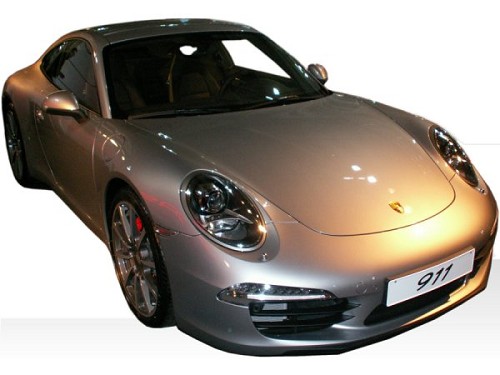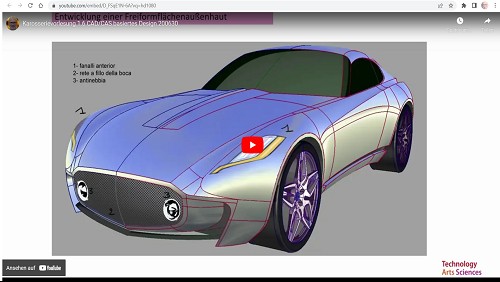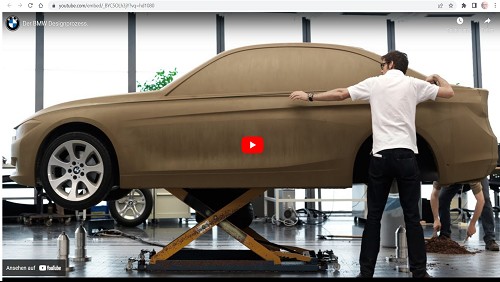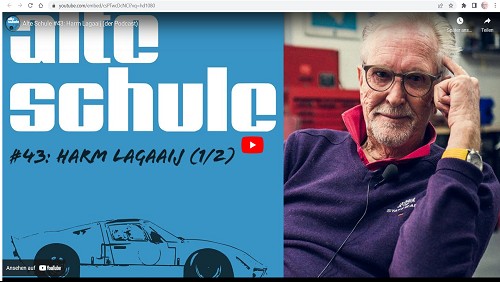 Car Body Car Body

kfz-tech.de/PME103
What is so special about a car body? Of course, like with a building, no water should penetrate into the interior, which is a particular challenge because a car body is often moved by severe weather. Incidentally,
this is still checked at least randomly on new vehicles.
When 'movement' is the key word, air resistance immediately comes into play. There is therefore a clearly defined direction in which such a body moves through the air. Only very few cars are said to have had a
better cW value when reversing than when moving forward.
By the way, this value only depicts the shape, so it still has to be multiplied by the cross-sectional area. You can see how important this is. From around 50 km/h, air resistance is considered the most
important obstacle on the way to a fuel-efficient car, also because it increases with the square of the speed.
Bodies are usually made of sheet steel. This applies to the driver's cab of a truck. Buses usually consist of a planked skeleton, the former and the latter in a self-supporting design. Aluminum is being used to an
ever greater extent and has become more energy-efficient to manufacture thanks to recycling. Glass fiber reinforced plastic is only suitable for add-on parts.
Carbon would be ideal for the immediate cage around the passengers, but this has proven to be too complex to produce and therefore too expensive for series production. Steel and aluminum sheet is often cold-
pressed several times to stabilize the shape and can be processed directly.
The production of the body can be adapted particularly well to the target duration of around 10 hours because it is already almost fully automated. The only critical factor is the composition, which is more than
millimeter accurate. The actual painting, with the exception of parts of the preparation and inspection, no longer requires human hands.
The introduction of electromobility also has an impact on the body. Although it is higher, it should actually be more aerodynamic to achieve greater ranges. The cardan tunnel is no longer needed, while stability
must be provided by an external frame, also and not least to protect the battery in the event of an accident.
Their housing is still hardly included in the calculation of the stability of the entire body, which would bring a small weight advantage. The batteries are also rather continuous, with far too few gaps left for the feet
of passengers on pure electric platforms. Because of the 4-wheel drives, a lot of space is often wasted even on the corresponding 2-wheel drives.
Together with design gimmicks and safety requirements, the all-round view to the outside has deteriorated significantly, not only due to the size of the body also the clarity. Measures to counteract this include
the higher seating position and camera systems or acoustic warnings. This helps enormously, especially with trucks, buses and vans.
The importance of appearance in relation to purchasing behavior has remained. The lighting units at the front and rear are playing an increasingly important role. All of this helps to make the vehicles of one brand
a little more distinguishable from those of another. However, this used to be much easier.
Incredible things have been achieved in the field of accident safety. In one of the tests, however, the car hit a soft paneling on one side at 64 km/h without braking. In the past, nothing would have been left of the
car or the passengers. The particularly important side impact has also been significantly improved.
What a vulnerability to corrosion there used to be. Presumably since galvanizing, this is no longer an issue. Wax in cavities also contributes to durability. You only have to worry about this if the vehicle would
have severely deformed in an accident. Repair methods have improved a lot, but a certain amount of mistrust regarding durability is justified.
Today, paint is particularly thin despite the many layers. You can measure it and thus protect yourself from using too much filler when buying a used car. It is amazing how much movement paint can take in the
sheet metal, as is vividly demonstrated when you remove dents without painting. Even laminated glass panes can be repaired, albeit under very restrictive conditions.
The use of glass is somewhat limited in electric mobility. It is used generously in the roof, but this cannot be opened. Convertibles have returned to fabric roofs. They may look more leisurely, but are usually
significantly heavier. Their stability in the event of an accident is also likely to be somewhat lower.
The next stage of evolution will come in the bodywork with the introduction of true automated driving, but it will probably be a while before it happens.

kfz-tech.de/YME53

kfz-tech.de/YME54

kfz-tech.de/YME55

kfz-tech.de/YME56
|